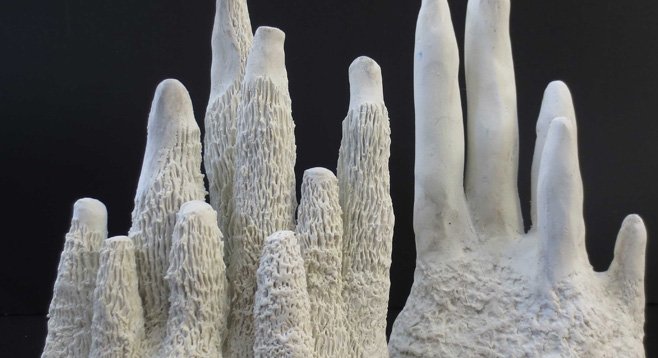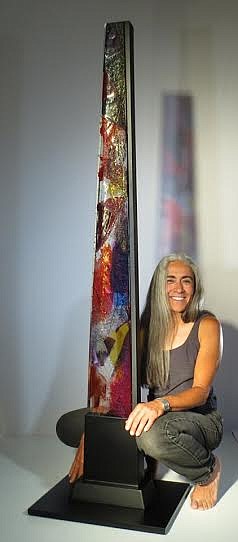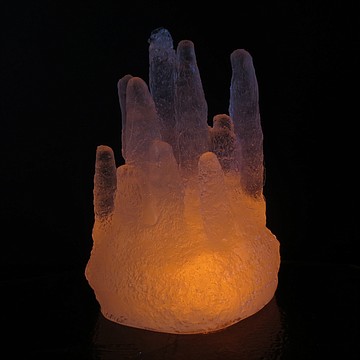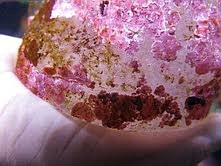 Facebook
Facebook
 X
X
 Instagram
Instagram
 TikTok
TikTok
 Youtube
Youtube

“I know that when you combine statistics and art, you have a way of reaching people that’s much deeper, because you’re reaching them through the heart,” says Kira Corser, director of “Sea Changes: Act.” The project is part of DNA of Creativity, which seeks to unite San Diego’s arts and sciences communities and promote cross-disciplinary projects to effect positive social change.

“Our project addresses three issues that critically endanger the ocean. One is plastic pollution, one is climate change, especially acidification of the ocean and its effect on coral reefs and hard-shelled creatures like crabs, and the third is overfishing. In our lifetime, we may end up seeing the end of [commercial] fishing as we know it.
"By pairing scientists and artists together through DNA of Creativity, our goal was to create possible solutions. [Local artist] Michelle Kurtis Cole, working with [NOAA fisheries official] Dale Sweetnam, designed the experiment at the Birch Aquarium.”
The project in question is only part of “Sea Changes,” but it’s finally coming to fruition after more than a year. The project at the aquarium involves creating artificial substrates that provide a base from which coral reefs can regrow. The substrates, which are works of art in their own right, are made by Cole in her Cardiff studio.
Cole describes the process, saying, “I make a model, in this case a coral-like sculpture, and then I make a mold for it that will withstand great heat. Instead of pouring molten glass in, I place solid pieces of glass into the mold, and then I fire it. I have a six-by-nine-foot kiln and I fire the glass at about 1600 degrees fahrenheit. It’s pretty exciting, because I go inside the kiln a few times to check the process. I’m wearing an aluminum suit and a face shield, so I look like a spaceperson. When it’s finished, the sculpture takes days to cool down in an annealing process that takes the stresses out of the glass. I carve, polish, and engrave it in whatever way I want. It’s a lot of fun and a lot of work.”

The project’s scientists monitor the experiment, recording which forms and textures of glass are most conducive to coral growth. After five months in the aquarium’s coral regen tank, polyps have begun to attach themselves to the artificial substrates with no interference from the team.
“We didn’t seed our glass corals [by attaching already living coral to the substrate in order to promote new growth]. We just created the base and gave it time,” says Cole, who refers to coral reefs as “the rainforests of the ocean,” citing their vital importance in marine ecology.
Cole was partly drawn to the project because of her long history as a SCUBA diver.
“I’ve been diving for over thirty years,” she says. “I’ve had opportunities to dive all over the world, fall in love with the ocean, and fall in love with coral. About twenty years after I started diving, I went back to a reef — the very first reef I ever dove — and found it dead. The coral was dead and bleached, everything was dead. It really just broke my heart. I always wanted to do something, and this project is a perfect fit.”

While some people think the divide between art and science isn’t easily bridged, Kira Corser has found that there’s more common ground between artist and scientists than there are differences.
“One of the things I’ve found with this project is that both scientists and artists have an amazing curiosity about life,” she says.
“Scientists and artists are also both used to problem solving. They both look at something and say, ‘how can this be fixed?’ Scientists come at it with statistics and research, whereas artists approach the problem with imagination and personal experience. In both fields, you try things until you get success. A lot of people give up. I’ve taught every age you can imagine, and I’ve seen how art can open up possibilities where people thought there were none.”
Corser describes art as a form of “visual literacy” that can convey the importance of a message without relying on hard data, because not everybody speaks the language of numbers.
The ultimate purpose of “Sea ChangeS: Act” is to educate and inspire people to take an active role in changing humanity’s relationship to the ocean.
“What is it that makes somebody act?” Corser asks the world at large. “You can tell people that millions of fish are dying, and that 50,000 marine birds are killed every year, but what makes them want to do something different? There has to be some emotional connection there. Art has incredible power. People don’t even realize what they can accomplish when they care about something.”
The “Sea Changes” team wants to show people that there are options out there, that the oceans are not a lost cause. The long term goal of the glass reef project is to make large sections of reef and be able to sink them in the ocean, provided the team can find a place that will let them do that. Manmade reefs around the world have become destinations for divers and fisherman. That gives the natural reefs a break, so to speak, allowing them the chance to live. If all goes well, they’ll look to experiment with large-scale glass reef substrate in 2014. An exhibition of the whole project is set to kick off at the Oceanside Museum of Art in 2014.


“I know that when you combine statistics and art, you have a way of reaching people that’s much deeper, because you’re reaching them through the heart,” says Kira Corser, director of “Sea Changes: Act.” The project is part of DNA of Creativity, which seeks to unite San Diego’s arts and sciences communities and promote cross-disciplinary projects to effect positive social change.

“Our project addresses three issues that critically endanger the ocean. One is plastic pollution, one is climate change, especially acidification of the ocean and its effect on coral reefs and hard-shelled creatures like crabs, and the third is overfishing. In our lifetime, we may end up seeing the end of [commercial] fishing as we know it.
"By pairing scientists and artists together through DNA of Creativity, our goal was to create possible solutions. [Local artist] Michelle Kurtis Cole, working with [NOAA fisheries official] Dale Sweetnam, designed the experiment at the Birch Aquarium.”
The project in question is only part of “Sea Changes,” but it’s finally coming to fruition after more than a year. The project at the aquarium involves creating artificial substrates that provide a base from which coral reefs can regrow. The substrates, which are works of art in their own right, are made by Cole in her Cardiff studio.
Cole describes the process, saying, “I make a model, in this case a coral-like sculpture, and then I make a mold for it that will withstand great heat. Instead of pouring molten glass in, I place solid pieces of glass into the mold, and then I fire it. I have a six-by-nine-foot kiln and I fire the glass at about 1600 degrees fahrenheit. It’s pretty exciting, because I go inside the kiln a few times to check the process. I’m wearing an aluminum suit and a face shield, so I look like a spaceperson. When it’s finished, the sculpture takes days to cool down in an annealing process that takes the stresses out of the glass. I carve, polish, and engrave it in whatever way I want. It’s a lot of fun and a lot of work.”

The project’s scientists monitor the experiment, recording which forms and textures of glass are most conducive to coral growth. After five months in the aquarium’s coral regen tank, polyps have begun to attach themselves to the artificial substrates with no interference from the team.
“We didn’t seed our glass corals [by attaching already living coral to the substrate in order to promote new growth]. We just created the base and gave it time,” says Cole, who refers to coral reefs as “the rainforests of the ocean,” citing their vital importance in marine ecology.
Cole was partly drawn to the project because of her long history as a SCUBA diver.
“I’ve been diving for over thirty years,” she says. “I’ve had opportunities to dive all over the world, fall in love with the ocean, and fall in love with coral. About twenty years after I started diving, I went back to a reef — the very first reef I ever dove — and found it dead. The coral was dead and bleached, everything was dead. It really just broke my heart. I always wanted to do something, and this project is a perfect fit.”

While some people think the divide between art and science isn’t easily bridged, Kira Corser has found that there’s more common ground between artist and scientists than there are differences.
“One of the things I’ve found with this project is that both scientists and artists have an amazing curiosity about life,” she says.
“Scientists and artists are also both used to problem solving. They both look at something and say, ‘how can this be fixed?’ Scientists come at it with statistics and research, whereas artists approach the problem with imagination and personal experience. In both fields, you try things until you get success. A lot of people give up. I’ve taught every age you can imagine, and I’ve seen how art can open up possibilities where people thought there were none.”
Corser describes art as a form of “visual literacy” that can convey the importance of a message without relying on hard data, because not everybody speaks the language of numbers.
The ultimate purpose of “Sea ChangeS: Act” is to educate and inspire people to take an active role in changing humanity’s relationship to the ocean.
“What is it that makes somebody act?” Corser asks the world at large. “You can tell people that millions of fish are dying, and that 50,000 marine birds are killed every year, but what makes them want to do something different? There has to be some emotional connection there. Art has incredible power. People don’t even realize what they can accomplish when they care about something.”
The “Sea Changes” team wants to show people that there are options out there, that the oceans are not a lost cause. The long term goal of the glass reef project is to make large sections of reef and be able to sink them in the ocean, provided the team can find a place that will let them do that. Manmade reefs around the world have become destinations for divers and fisherman. That gives the natural reefs a break, so to speak, allowing them the chance to live. If all goes well, they’ll look to experiment with large-scale glass reef substrate in 2014. An exhibition of the whole project is set to kick off at the Oceanside Museum of Art in 2014.
Comments